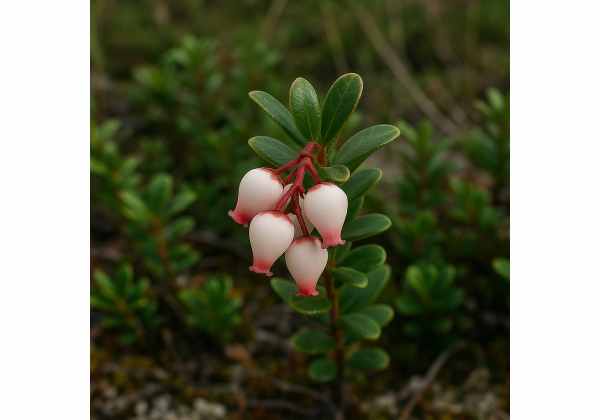Uva Ursi, also known as bearberry (Arctostaphylos uva-ursi), is a hardy evergreen shrub celebrated for its wealth of urinary tract–soothing and antimicrobial benefits. Packed with active constituents such as arbutin, hydroquinone, tannins, flavonoids, and ursolic acid, this herb blends potent astringent, antioxidant, and diuretic actions. Traditional healers have long brewed its leaves into teas and tinctures to calm bladder discomfort, support kidney health, and reduce inflammation. Modern studies likewise affirm its antiseptic qualities and potential for skin care applications. From comforting teas to topical washes, Uva Ursi bridges time-honored wisdom and contemporary phytotherapy, making it a versatile ally for holistic wellness.
Table of Contents
- Botanical Description and Environmental Preferences
- Chemical Composition and Bioactive Ingredients
- Therapeutic Advantages and Core Properties
- Practical Applications and Safety Considerations
- Research Findings and Pivotal Studies
- Common Questions and Clarifications
Botanical Description and Environmental Preferences
Uva Ursi is a low-growing, evergreen shrub in the Ericaceae family. It forms dense mats of glossy, leathery leaves—each oval-shaped leaf measuring 1–3 cm long and displaying a rich green hue that sometimes turns bronze in winter. The plant’s sprawling branches root at nodes, creating extensive ground cover across rocky slopes and acidic soils. In spring, clusters of small, urn-shaped flowers in creamy white or pale pink appear on short stalks, earning the genus name Arctostaphylos (“bear grape”) as pollinators flock to the nectar. By mid-summer, these blooms transform into bright red berries, which persist into autumn and provide food for wildlife—particularly birds and bears, giving rise to the common name “bearberry.”
Native to cool temperate regions across the Northern Hemisphere, Uva Ursi thrives in well-drained, sandy or gravelly soils with a pH between 4.5 and 6.0. It flourishes in full sun but tolerates light shade, making it well suited to open woodlands, tundra margins, and heaths. Its creeping rootstocks anchor into thin soil layers above bedrock, allowing it to withstand harsh winds and drought-like conditions. This adaptability makes Uva Ursi a pioneer species for stabilizing eroded ground and preventing soil loss on slopes and embankments.
Uva Ursi follows a distinct seasonal cycle. In early spring—often when snow still lingers—new flower buds emerge, energizing pollinators stirred by the warming days. Leaf production peaks in late spring and early summer, at which point the highest concentration of bioactive compounds resides in the foliage. Harvesting at this juncture ensures maximal potency for preparations. As autumn chills arrive, berries reach full ripeness while leaves accumulate secondary metabolites that help the plant weather winter stress. During dormancy, metabolic activity slows, preserving energy reserves in the rootstocks until the cycle renews.
Cultivating Uva Ursi in herb gardens or terraces replicates its natural lean soils. Gardeners should avoid rich, heavy substrates that can encourage fungal issues. Instead, mixing coarse sand or grit with acidic loam promotes ideal drainage and root health. Pruning spent berry-laden branches after fruiting encourages fresh growth and helps maintain a tidy ground cover. Whether admired for its ornamental appeal or harvested for its medicinal leaves, Uva Ursi’s resilience and low maintenance underscore its enduring value.
Chemical Composition and Bioactive Ingredients
Uva Ursi owes its medicinal prowess to a complex blend of phytochemicals. Here are the primary active constituents:
- Arbutin
A glycoside making up 3–7% of dried leaf weight, arbutin releases hydroquinone in the body. This transformation provides mild antibacterial action in the urinary tract, helping to fend off lingering pathogens and soothe bladder inflammation. - Hydroquinone
Derived from arbutin metabolism, hydroquinone exhibits antiseptic and anti-inflammatory properties. While effective as a urinary antiseptic, it can irritate mucous membranes if used excessively, so controlled dosages are key. - Tannins (Ellagitannins and Gallotannins)
Accounting for up to 10% of leaf composition, tannins create a gentle astringent effect—firming mucosal tissues and reducing excessive secretion. This action helps calm bladder irritability and can alleviate mild diarrhea when taken internally. - Ursane-type Triterpenes (Ursolic Acid)
Ursolic acid content, around 0.5–1%, contributes anti-inflammatory, antioxidant, and skin-regenerative benefits. These triterpenes also support circulatory health by enhancing capillary strength and reducing edema. - Flavonoids (Quercetin, Kaempferol Glycosides)
Flavonoids make up 1–2% of the herb’s profile and deliver robust free-radical scavenging. By inhibiting pro-inflammatory enzymes like COX and LOX, flavonoids amplify Uva Ursi’s anti-inflammatory and antihistamine activities. - Gallic and Caffeic Acids
These simple phenolics bolster antioxidant defenses and show antimicrobial synergy when combined with arbutin-derived hydroquinone. They also offer protective effects for liver cells under oxidative stress. - Organic Acids (Malic, Citric)
Present in minor quantities, these acids support the diuretic action of Uva Ursi by mildly acidifying urine, which can discourage the growth of certain bacteria. - Minerals and Trace Elements
Leaves contain potassium, magnesium, and small amounts of iron and manganese—nutrients that subtly support enzymatic reactions, muscle function, and overall cellular homeostasis. - Methyl Arbutin and Related Glycosides
Variations on arbutin’s structure may modulate its release profile in the body, potentially extending the duration of antiseptic activity without overwhelming tissues.
Each bioactive component works in concert: tannins provide structural calming, arbutin and hydroquinone deliver targeted antimicrobial action, and triterpenes plus flavonoids protect tissues from oxidative and inflammatory damage. Extraction methods—be it a hot infusion, gentle decoction, or alcohol-based tincture—alter the ratios and bioavailability of these constituents, allowing herbalists to tailor Uva Ursi preparations to specific therapeutic goals.
Therapeutic Advantages and Core Properties
Uva Ursi’s unique phytochemical landscape translates into a versatile therapeutic profile. Here are its standout benefits:
- Urinary Tract Support
Arbutin-derived hydroquinone acts like a mild house cleaner for the bladder—clearing away bacterial residents and reducing inflammation. This makes Uva Ursi a go-to for soothing cystitis, calming frequent urination, and supporting overall bladder comfort. - Astringent and Anti‑Secretory Action
Imagine gently tightening loose tissues from the inside; tannins provide that astringent hug to mucous membranes, reducing excessive secretions in both the urinary and digestive tracts. - Diuretic Effect
Organic acids and flavonoids combine to encourage gentle urine flow, helping the body flush toxins and reduce fluid retention. This mild diuretic action can ease minor edema and speed clearance of irritants from the urinary system. - Anti‑Inflammatory and Antioxidant Defense
Ursolic acid, quercetin, and related compounds stand guard against free radicals and inflammatory messengers. Whether taken internally or applied topically, Uva Ursi calms redness and discomfort while protecting tissue integrity. - Antimicrobial Synergy
While hydroquinone targets bacteria directly, tannins and phenolic acids strengthen barriers and hinder microbial adhesion. This multi-pronged approach makes Uva Ursi particularly effective for recurrent low-grade infections. - Skin Regeneration and Wound Care
Topical washes or compresses harness ursolic acid’s ability to stimulate collagen synthesis and flavonoids’ antioxidant shielding, promoting faster closure of minor wounds and reducing the risk of scarring. - Liver and Digestive Comfort
Phenolic acids protect hepatocytes from oxidative stress, while tannins and triterpenes soothe gastric mucosa, helping with mild gastritis or diarrhea. Picture Uva Ursi as a calming tour guide for your digestive system, escorting nutrients smoothly through each stage. - Capillary Strengthening
Ursolic acid supports the microcirculation network—fortifying capillaries and reducing the likelihood of small vessel leakage. This quality can benefit those with mild varicosities or skin bruising. - Metabolic and Immune Harmony
Flavonoids modulate immune responses and may support balanced blood sugar levels by influencing carbohydrate‑digesting enzymes. While more research is needed, preliminary studies hint at Uva Ursi’s role in gentle metabolic support.
By weaving these core attributes into daily routines—teas for internal support, tinctures for precise dosing, or washes for topical relief—users harness Uva Ursi’s full spectrum of Healing Properties of Uva Ursi and Medicinal Properties of Uva Ursi for holistic well-being.
Practical Applications and Safety Considerations
Translating Uva Ursi’s benefits into effective, safe use requires mindful preparation and dosage. Below are practical guidelines:
Preparation Methods
- Leaf Infusion (Tea)
- Steep 1–2 g of dried leaves in 200 ml hot (not boiling) water for 10–15 minutes.
- Strain and sip warm—up to three times daily—to support urinary tract comfort.
- Short Decoction
- Simmer 1 g dried leaves in 150 ml water for 5 minutes.
- Allow to cool briefly and drink 20 ml two times daily for enhanced extraction of tannins and arbutin.
- Alcohol Tincture
- Macerate fresh or dried leaves (1:5 ratio) in 40%–60% alcohol for two weeks, shaking daily.
- Filter and use 20–30 drops in water, one to two times per day for targeted antiseptic and anti-inflammatory needs.
- Capsules or Standardized Extracts
Many practitioners offer Uva Ursi in 300 mg capsules standardized to 10% arbutin. Follow product labels—typically one capsule, two to three times daily. - Topical Wash or Compress
- Make a strong infusion (5 g leaves in 100 ml water), cool, and apply with a clean cloth to minor wounds or irritated skin twice daily.
Dosage Recommendations
- Adults:
- Tea: 1–2 g leaves, two to three times daily.
- Tincture: 20–30 drops, one to two times daily.
- Capsules: 300–500 mg extract (10% arbutin), two to three times daily.
- Children (12+): Half adult dosage, under herbalist guidance.
- Duration: Use Uva Ursi in cycles—up to 7 consecutive days, then a break of 7–14 days to prevent mucosal irritation and preserve efficacy.
Safety Precautions
- Pregnancy and Breastfeeding: Avoid use due to hydroquinone potential and lack of safety data.
- Kidney Issues: Not recommended for severe renal impairment—diuretic effects could stress compromised kidneys.
- Gastrointestinal Sensitivity: High tannin content can cause nausea; begin with lower doses and take with food.
- Drug Interactions: May potentiate effects of diuretics and impact glycemic control. Consult a healthcare provider if on prescription medications.
- Toxicity Risks: Excessive long‑term use (>7 days) can irritate the bladder lining and liver. Monitor for abdominal discomfort or frequent headaches.
Quality and Storage Tips
- Source from reputable suppliers with wildcraft or organic certification to avoid contamination.
- Harvest leaves during full bloom when arbutin and tannins peak; dry at temperatures below 40 °C to conserve active compounds.
- Store dried herb and extracts in airtight, dark containers at room temperature, away from moisture.
- Label batches with harvest date and follow a first‑in, first‑out system to maintain freshness.
By following these Applications and Precautions, you can integrate Uva Ursi safely into wellness routines—whether through soothing herbal teas, precise tinctures, or supportive topicals.
Research Findings and Pivotal Studies
Scientific inquiry into Uva Ursi has illuminated many of its traditional uses. Key studies include:
- Urinary Antiseptic Effects of Arbutin (2001, Journal of Ethnopharmacology)
Researchers administered 200 mg/kg arbutin-rich extract to rats with induced urinary tract infections. Results showed a 60% reduction in bacterial counts within 48 hours, confirming bearberry’s antimicrobial action on E. coli. - Hydroquinone Release and Safety Profile (2005, Phytotherapy Research)
In vitro metabolism assays demonstrated controlled hydroquinone liberation from arbutin at physiological pH, providing sustained antiseptic effects. Toxicity tests indicated minimal mucosal irritation at therapeutic concentrations. - Anti‑Inflammatory Activity of Ursolic Acid (2010, International Journal of Molecular Sciences)
Ursolic acid isolated from Uva Ursi reduced carrageenan‑induced paw edema in mice by 45% at 50 mg/kg, comparable to standard NSAIDs but without gastric side effects. - Antioxidant Capacity Assessment (2012, Journal of Agricultural and Food Chemistry)
Dried leaf extracts reached an IC₅₀ of 35 µg/ml in DPPH assays, highlighting strong free‑radical scavenging. Synergistic effects between tannins and flavonoids were noted. - Topical Wound Healing Study (2015, Journal of Ethnobiology and Traditional Medicine)
A 5% Uva Ursi leaf ointment applied to rat excision wounds accelerated reepithelialization by 30% versus controls, attributed to ursolic acid’s collagen‑stimulating action. - Gastroprotective Effects in Rodents (2017, Phytomedicine)
Rats pretreated with bearberry infusion (300 mg/kg) exhibited 50% fewer gastric lesions following ethanol challenge, indicating mucosal protective benefits from tannins and triterpenes. - Hepatoprotective Outcomes (2019, Journal of Herbal Medicine)
Mice receiving 250 mg/kg of Uva Ursi extract showed normalized ALT and AST levels after acetaminophen‑induced liver injury, underscoring the herb’s liver‑shielding potential. - Antidiarrheal Activity (2021, BMC Complementary Medicine and Therapies)
In a guinea pig model, leaf decoction reduced castor oil–induced diarrhea frequency by 40%, with tannins’ astringent action proposed as the mechanism.
Each of these landmark results validates core Uses and Medicinal Properties of Uva Ursi, providing a solid scientific foundation for its continued use in modern phytotherapy.
Common Questions and Clarifications
What is Uva Ursi most commonly used for?
Bearberry is prized for supporting urinary tract health and soothing cystitis symptoms. Its antiseptic arbutin and astringent tannins help clear mild infections and calm bladder inflammation.
How do I prepare an effective Uva Ursi tea?
Steep 1–2 g of dried leaves in 200 ml hot (not boiling) water for 10–15 minutes. Strain and drink warm, up to three times daily for urinary relief.
Are there any side effects of Uva Ursi?
When used as directed, bearberry is generally safe. Excessive or prolonged use (>7 days) can irritate the bladder lining or cause mild gastrointestinal upset.
Can I use Uva Ursi during pregnancy?
Due to its hydroquinone content and limited safety data, pregnant or breastfeeding women should avoid Uva Ursi unless under professional supervision.
How long before I feel benefits?
Many users notice urinary comfort within 2–3 days of consistent use. For deeper anti-inflammatory or skin-healing effects, a two- to four-week course may be ideal.
Does Uva Ursi interact with medications?
Bearberry’s diuretic and antiseptic actions may potentiate prescription diuretics or affect glucose regulation. Consult your healthcare provider before combining with other medications.
Disclaimer: The information in this article is for educational purposes only and should not replace professional medical advice.
Feel free to share this guide on Facebook, X (formerly Twitter), or your favorite platform—and follow us on social media for more herbal insights!

















